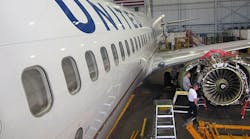Jet-engine builder Pratt & Whitney is applying "big data" analytics in a series of projects underway — 14 in total — to improve engine performance and customer service. The first example will be a predictive model, being developed in house by Pratt & Whitney engineers and analysts, to monitor “engine event” performance. The OEM expects the model to support more proactive maintenance scheduling and preparation for P&W engines.
This intelligence will help operators to optimize fleet operations and reduce maintenance costs, overall, according to Pratt & Whitney.
The research efforts incorporate both expertise from academic and industrial sources expertise, including IBM, the MIT Leaders for Global Operations, and the United Technologies Research Center. Projects underway now seek to optimize Pratt & Whitney's engine leasing business, so as to enhance the shop-visit allocation process across Pratt & Whitney's partner network; and to analyze shop-visit pricing to improve the company's predictive maintenance cost model.
These projects will advance Pratt & Whitney's service capabilities, which will lead to tangible value service offerings that will benefit customers.
"In only one year, we have expanded our capabilities in ‘big data’ exponentially," stated Matthew Bromberg, president, Pratt & Whitney Aftermarket. "Improving the performance of our engines and maintenance predictability are two critical components of optimizing the value we give our customers."
One project already declared successful involves a predictive model that Pratt & Whitney researchers developed to monitor engine event performance, which has increased aircraft fleets’ proactive maintenance planning efforts, and improved their maintenance requirements.
That project initially focused on field operational data and system health information data from PW4000 100-inch engines. It has been expanded to encompass similar data for all PW4000 engine models.
“This intelligence can help operators optimize fleet operations and reduce maintenance costs,” according to the source.
Also currently, Pratt & Whitney is identifying its opportunities for collaborating with airlines to optimize processes and develop critical model performance metrics that will further progress the company's database of information on engine conditions and performance.
A similar predictive analytics model is being built to support the V2500® engine fleet, in a separate project.
"We have a number of development projects underway, and we incorporate ‘learnings’ as we go," stated Lynn Fraga, business analytics manager, Pratt & Whitney Engine Services. "These programs will continue to evolve and grow over time, as we narrow our focus on services and metrics most important to our customers."








